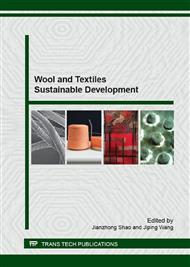[1]
A. Khatri, M.H. Peerzada, M. Mohsin, M. White, A review on developments in dyeing cotton fabrics with reactive dyes for reducing effluent pollution, Cleaner Prod. 87 (2015) 50-57.
DOI: 10.1016/j.jclepro.2014.09.017
Google Scholar
[2]
C. Allegre, P. Moulin, M. Maisseu, F. Charbit, Treatment and reuse of reactive dyeing effluents, Membr. Sci. 269 (2006) 15-34.
DOI: 10.1016/j.memsci.2005.06.014
Google Scholar
[3]
R. Jiraratananon, A. Sungpet, P. Luangsowan, Performance evaluation of nanofiltration membranes for treatment of effluents containing reactive dye and salt, Desalination. 130 (2000) 177-183.
DOI: 10.1016/s0011-9164(00)00085-0
Google Scholar
[4]
Y. Yang, L. Xu, Reusing hydrolyzed reactive dyebath for nylon and wool dyeing, Am. Dyest. Rep. 85 (1996) 27-34.
Google Scholar
[5]
M. Banchero, Supercritical fluid dyeing of synthetic and natural textiles–a review, Color. Technol. 129 (2013) 2-17.
Google Scholar
[6]
G.B. Montero, C.B. Smith, W.A. Hendrix, D.L. Butcher, Supercritical fluid technology in textile processing: an overview, Ind. Eng. Chem. Res. 39 (2000) 4806-4812.
DOI: 10.1021/ie0002475
Google Scholar
[7]
T. Hori T, A. Kongdee, Dyeing of PET/co-PP composite fibers using supercritical carbon dioxide, Dyes Pigm. 105 (2014) 163-166.
DOI: 10.1016/j.dyepig.2014.01.023
Google Scholar
[8]
J. Long, H. Xu, C. Cui, X. Wei, F. Chen, A. Cheng, A novel plant for fabric rope dyeing in supercritical carbon dioxide and its cleaner production, J. Cleaner Prod. 65 (2014) 574-582.
DOI: 10.1016/j.jclepro.2013.08.008
Google Scholar
[9]
G. Cocoros, T.V. Chambers, J. J. Hirshfeld. U.S. Patents, (1978).
Google Scholar
[10]
B. Wang, X Ruan, L. Chen, J. Chen, Y. Yang, Heterogeneous Chemical Modification of Cotton Cellulose with Vinyl Sulfone Dyes in Non-Nucleophilic Organic Solvents, Ind. Eng. Chem. Res. 53 (2014) 15802-15810.
DOI: 10.1021/ie503173m
Google Scholar
[11]
O. Acevedo, W.L. Jorgensen, Solvent effects and mechanism for a nucleophilic aromatic substitution from QM/MM simulations, Org. Lett. 6 (2004) 2881-2884.
DOI: 10.1021/ol049121k
Google Scholar
[12]
Cid M.V. Fernandez, W. Buijs, G. Witkamp, Application of molecular modeling in the optimization of reactive cotton dyeing in supercritical carbon dioxide, Ind. Eng. Chem. Res. 46 (2007) 3941-3944.
DOI: 10.1021/ie061076s
Google Scholar
[13]
C.C.R. Sutton, G.V. Franks, G. Da Silva, First principles pKa calculations on carboxylic acids using the SMD solvation model: effect of thermodynamic cycle, model chemistry, and explicit solvent molecules, J. Phys. Chem. B. 116 (2012).
DOI: 10.1021/jp305876r
Google Scholar
[14]
E. Kissa, Lightfastness of reactive dyes, Text. Res. J. 41 (1971) 715-719.
Google Scholar
[15]
F. Aricò, P. Tundo, Dimethyl carbonate: a modern green reagent and solvent, Russ. Chem. Rev. 79 (2010) 479-489.
DOI: 10.1070/rc2010v079n06abeh004113
Google Scholar
[16]
G. Koller,U. Fischer, K. Hungerbühler, Assessing safety, health, and environmental impact early during process development, Ind. Eng. Chem. Res. 39 (2000) 960-972.
DOI: 10.1021/ie990669i
Google Scholar
[17]
T.L. Dawson, The reaction mechanism and fixation of monochloro-s-triazine dyes on cellulose using tertiary amine catalysts, J. Soc. Dyers Colour. 80 (1964) 134-143.
DOI: 10.1111/j.1478-4408.1964.tb02584.x
Google Scholar


